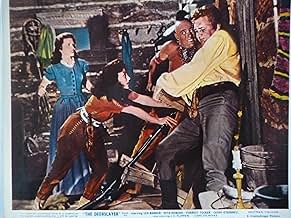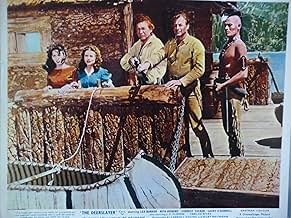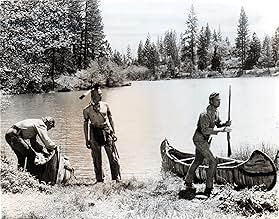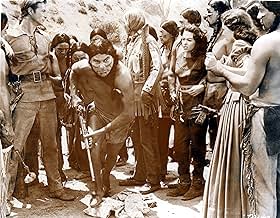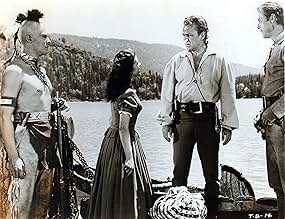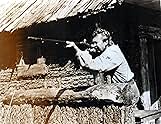En la América colonial, el merodeador Deerslayer se ve envuelto con Tom Hutter, un hombre intolerante, y sus dos hijas.En la América colonial, el merodeador Deerslayer se ve envuelto con Tom Hutter, un hombre intolerante, y sus dos hijas.En la América colonial, el merodeador Deerslayer se ve envuelto con Tom Hutter, un hombre intolerante, y sus dos hijas.
- Dirección
- Guionistas
- Elenco
Opiniones destacadas
in CinemaScope and Color by De Luxe and a memorable score by Paul Sawtell and Bert Shefter.
At the time, I thought this film was marvellous and very exciting, especially the Indian attack on the fort in the middle of the lake. Me and my pals had a new hero in The Deerslayer and incorporated him into our games of cowboys and Indians in which some of us would play the Hurons, mown down mercilessly by the musket fire of the other boys.
This may seem very strange now to younger readers of this site who can't remember the 1950's, but this was the way it was then. Throughout our childhood, we had been indoctrinated by the cinema into believing that what would now be considered racist ideas about native Americans were correct. They were represented as "squalling polecats" and "savages" and "heathens", not as people. Just as anonymous targets to be mown down. A hindrance and a thorn in the side of white settlers pushing the frontier Westward.
So this film is a product of its time and should not be judged by our modern standards. There had been the very isolated film like BROKEN ARROW, that gave a more accurate and sympathetic view of the American Indian, but for every BROKEN ARROW, there were a dozen films of the calibre of THE DEERSLAYER; THE GUNS OF FORT PETTICOAT and DRAGOON WELLS MASSACRE. I do not think that our ideas as children about Red Indians would have been considered racist in 1957, because we kids had never heard that word at that time. But I like to think that we've all grown up a lot in our knowledge and attitudes since then. After all, I realise now that the Indians were fighting for their land, which was being stolen from them by the whites and fighting to preserve their way of life. They had a right to fight back. Looked at today, THE DEERSLAYER may look corny and racist, but it was filmed in 1957, not 2003. For it's time, then, a rousing Boy's Own adventure that would have been popular with juveniles. Modern boys in the eight to thirteen age bracket, though, probably wouldn't like it.
Deerslayer & his faithful Indian companion Chingachgook stumble onto an old trader (Tucker) who asks for their help in protecting a crazy old man & his two daughters from a Huron assault. Well-groomed & stoic throughout, Deerslayer agrees (for some reason) & meets the old man on his floating fort in the middle of the river. The crazy codger hates Indians, & he seems to pamper & flatter his oldest daughter while telling his youngest (played by Moreno) that she's feeble-minded. Deerslayer has suspicions about the whole set-up, but you don't have to be an avid mystery-novel reader to figure out the reasons behind the Huron charge. Barker, constantly posing with his gun & giving those humored looks at the women that George Reeves as Superman always did, plays an android Deerslayer, & the fight scenes are about as exciting as the cliched "Yi yi yi" the Huron holler out when attacking is threatening.
I guess this was made for the Saturday-morning-movie crowd, but there's a part of me that can't believe that even children of the 1950s would be taken in by what now seems obvious: the ridiculously stereotyped Indians, the bad, off-the-screen violence poorly done, even the wooden performance by Barker must've been seen as more comic than heroic. Daniel Day-Lewis frantically saying, "Don't worry, I'll find you!" never looked better.
I never cared much for James Fennimore Cooper's novels, and reading Mark Twain's essay on the writer made it clear why. Cooper was not careful about choosing the right word, and his description of scenes was shoddy. Even so, I concede his situations were exciting, and his writings were ancestral to the westerns. With the help of some competent screenwriters -- including an uncredited Dalton Trumbo -- director Kurt Neumann crafted an exciting story that played into current liberal thoughts about interracial relations, and DP Karl Struss shot Bass Lake and the surrounding pine lands in the Sierra Nevada in a most becoming fashion.
The scenery with the cabin on the lake was stunning and to be honest, this is the best part of the movie.
It's not short on action, lots of gun fights, hand to hand combat and even a small cannon thrown in, some of it is not overly convincing but the movie is watchable and the decision to keep it short was sensible.
The acting such as when a guy got caught in a bear-trap is fairly basic and the whole thing, watching it now, is a little non-PC.
¿Sabías que…?
- Citas
Hetty Hutter: Then you're not sure then that the Hurons will give him up.
Deerslayer: Well, that depends upon what they want most: Old Tom or the scalps of their dead.
Harry March: What makes you think they want them scalps at all?
Deerslayer: Well, all Indians are superstitious, Hurons more than most. They believe that the spirit of the scalped warrior can never rest until the scalp is reclaimed.
Harry March: And then you can't go to the Happy Hunting Grounds without your hair on, huh?
- ConexionesReferenced in The Deerslayer (1978)
Selecciones populares
- How long is The Deerslayer?Con tecnología de Alexa
Detalles
- Tiempo de ejecución1 hora 18 minutos
- Color
- Relación de aspecto
- 2.35 : 1
Contribuir a esta página



